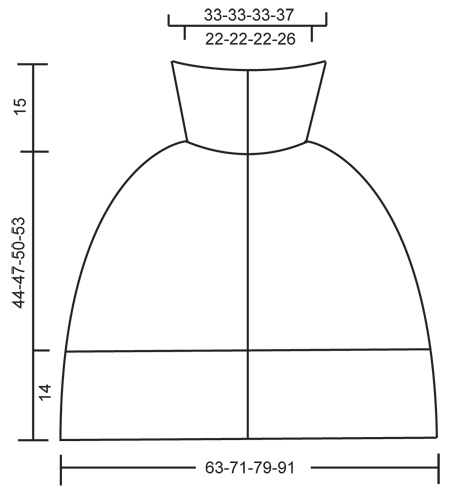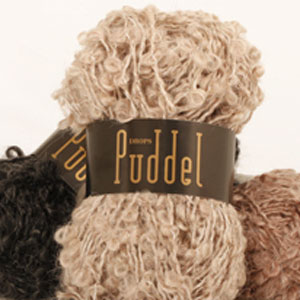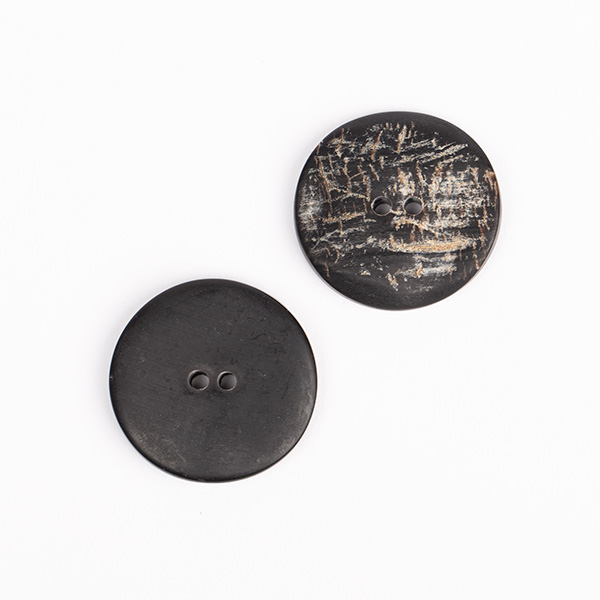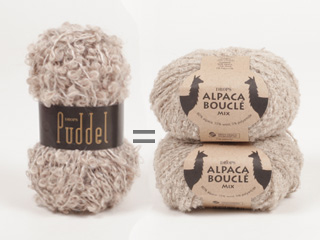Comments / Questions (23)
![]() Fraülein Von S wrote:
Fraülein Von S wrote:
Tycker mönstret ska heta Highlands (alternativt (cosy) in /for the Highlands)
01.03.2024 - 10:01
![]() Noëlle Kirscher wrote:
Noëlle Kirscher wrote:
Bonjour, Juste une précision : pour tricoter le pull "lavender smiles" en taille 2 ans il me faut bien 2 pelotes de laine drops air, et pour la taille 5/6ans, 2 pelotes également Merci pour votre reponse Cordialement
31.01.2024 - 11:31
![]() Inge wrote:
Inge wrote:
Hallo, Ich stricke dieses Teil mit zwei Farben Snow. Darum sind beide Maschenproben mit Nadel 9 korrekt. Soll ich dann mit Nadel 11 aufsetzen und dann auf 9 wechseln? Oder die Anleitung folgen: mit 9 aufsetzen und dann auf 7 wechseln? Danke und Grüße, Inge
11.10.2023 - 17:20DROPS Design answered:
Liebe Inge, behalten Sie Nadel 9, so stimmt die Maschenprobe (Nadelgröße bei Paddel ist verschieden um die gleiche Maschenprobe wie mit Snow zu haben). Viel Spaß beim stricken!
12.10.2023 - 09:09
![]() Marie wrote:
Marie wrote:
Bonjour, est-ce qu'il faut alterner les diminution avant et après chaque marqueur a tous les 6 rangs ou sur un même rang.
20.03.2018 - 16:29DROPS Design answered:
Bonjour Marie, vous diminuez la 1ère fois après chaque marqueur, la 2ème fois avant chaque marqueur, la 3ème fois après chaque marqueur, la 4ème fois avant chaque marqueur et ainsi de suite. Vous diminuez 8 m à chaque rang de diminutions et tricotez 5 rangs entre chaque rang de diminutions. Bon tricot!
20.03.2018 - 16:39
![]() Marie-France wrote:
Marie-France wrote:
Bonjour, a 18 cm est- ce qu'on commence toute suite les diminutions ou on fait encore 6 rangs avant de commencer les diminutions.??
20.03.2018 - 10:08DROPS Design answered:
Bonjour Marie-France, à 18 cm, on place les marqueurs (sans tricoter) et au rang suivant sur l'endroit on commence les diminutions, et on les répètes encore 2 fois tous les 6 rangs (= 3 fois au total) puis 3 fois tous les 4 rangs et 4-10 fois (cf taille) tous les 2 rangs. On diminue d'abord après chaque marqueur (1ères diminutions) puis avant chaque marqueur (2èmes diminutions) et on répète ainsi une fois avant, une fois après. Bon tricot!
20.03.2018 - 10:38
![]() Marie-France wrote:
Marie-France wrote:
Bonjour , comment laver ce modèle pour ne pas qu'il feutre. merci
11.03.2018 - 14:46DROPS Design answered:
Bonjour Marie-France, lisez attentivement les indications des étiquettes et vous trouverez ici quelques informations complémentaires sur l'entretien. Votre magasin saura également vous conseiller si nécessaire. Bon tricot!
12.03.2018 - 09:46
![]() Stephanie Hutton wrote:
Stephanie Hutton wrote:
Hi, just trying to decide which size to knit and struggling to find a size conversion on your site. What would a s/m be in UK terms. I'm a size 10 to 12. Best regards, Stephanie
05.11.2015 - 15:38DROPS Design answered:
Dear Mrs Hutton, you will find at the bottom of the pattern a measurement chart with all measurements taken flat from side to side (in cm) - compare these to a similar garment you have and like the shape to find out the matching size - read more about sizing here. Happy knitting!
05.11.2015 - 18:53
![]() Bonny McCormick wrote:
Bonny McCormick wrote:
This reminds me of "From Russia with Love" movie - hurry up with this one
13.09.2009 - 18:11
![]() Gabriele wrote:
Gabriele wrote:
Sehr schön. Mit einem Blazer darunter wird das Cape wintertauglich. Strick ich mir!
12.08.2009 - 16:23
![]() Marit Rasmussen wrote:
Marit Rasmussen wrote:
Hello Irene. I can help. You Can use regulars needles, but I have a circular needle that I dont use (80 cm). You can get it. Give me your adress, and I send it to you.
09.08.2009 - 14:52
DROPS 116-13 |
|
|
|
|
Short DROPS poncho in ”Snow” with collar and borders in ”Puddel”. Size S – XXXL.
DROPS 116-13 |
|
|
GARTER ST (back and forth on needle): K all rows. -------------------------------------------------------- -------------------------------------------------------- PONCHO: Worked back and forth on circular needle from mid front. Cast on 131-147-163-186 sts (includes 5 front band sts each side towards mid front) on circular needle size 9 mm / US 13 with Puddel. Change to circular needle size 7 mm / US 10 ½ and continue in GARTER ST – see above – for 14 cm / 5½". Now slip 5 front band sts each side on a stitch holder = 121-137-153-176 sts left on needle. Change to circular needle size 9 mm / US 13 and Snow and continue in stockinette st. REMEMBER THE GAUGE! When piece measures 18 cm / 7" insert 8 markers in piece as follows: First marker after 8-9-10-11 sts, then 15-17-19-22 sts between each marker, = 8-9-10-11 sts left after the last marker. On next row from RS dec 1 st after all markers by K2 tog. Repeat the dec on every 6th row a total of 3 times, then on every 4th row a total of 3 times and then on every other row a total of 4-6-8-10 times – NOTE: Dec alternately before and after all markers = 41-41-41-48 sts. When piece measures 44-47-50-53 cm / 17¼"-18½"-19¾"-21" slip sts on a stitch holder. LEFT FRONT BAND: Slip sts from stitch holder on left front band back on circular needle size 7 mm / US 10½. Work garter st back and forth with Puddel until front band fits poncho – now slip sts on the same stitch holder as sts at the top of piece. RIGHT FRONT BAND: Like left front band, but make 4 buttonholes. 1 BUTTONHOLE = bind off middle sts and cast on 1 new st on next row. Make buttonholes when piece measures (from cast on row): SIZE S/M: 15, 23, 31 and 39 cm / 6", 9" 12¼" and 15¼". SIZE L: 15, 24, 32 and 41 cm / 6", 9½", 12½" and 16⅛". SIZE XL/XXL: 15, 24, 33 and 42 cm / 6", 9½", 13" and 16½". SIZE XXXL: 15, 25, 34 and 44 cm / 6", 9½", 13⅜" and 17¼". The last buttonhole is made on collar. COLLAR: Slip all sts from stitch holder on circular needle size 7 mm / US 10½ = 51-51-51-58 sts. Work garter st back and forth on needle with Puddel. When collar measures 2 cm / ¾" make 1 buttonhole in line with the others on front band. When collar measures 5 cm / 2" inc 10 sts evenly = 61-61-61-68 sts. When collar measures 10 cm / 4" inc 10 sts again = 71-71-71-78 sts. Bind off loosely when collar measures 15 cm / 6". ASSEMBLY: Sew front bands to poncho in outer loops of sts. Sew on buttons. |
|

|
|
Have you finished this pattern?Tag your pictures with #dropspattern or submit them to the #dropsfan gallery. Do you need help with this pattern?You'll find 15 tutorial videos, a Comments/Questions area and more by visiting the pattern on garnstudio.com. © 1982-2025 DROPS Design A/S. We reserve all rights. This document, including all its sub-sections, has copyrights. Read more about what you can do with our patterns at the bottom of each pattern on our site. |



















































Post a comment to pattern DROPS 116-13
We would love to hear what you have to say about this pattern!
If you want to leave a question, please make sure you select the correct category in the form below, to speed up the answering process. Required fields are marked *.